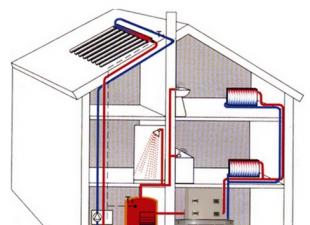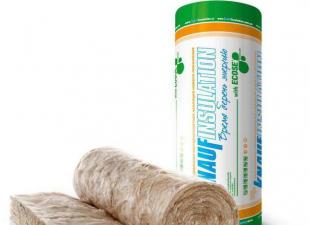To insulate sloping roofs, attic floors or the inner surface of walls, an excellent option would be to use Knauf insulation. This material is characterized by high quality and long service life. On the features, characteristics and scope of use of the Knauf insulation, we will consider further.
General information about insulation materials
The use of insulation is becoming more common both in the construction of private houses and high-rise buildings. The main feature of heaters is a very low level of heat conductivity. If we compare the thermal conductivity of a standard insulation and a brick, then it is eighteen times lower. Therefore, the installation of insulation significantly saves money on heating the house in the winter season.
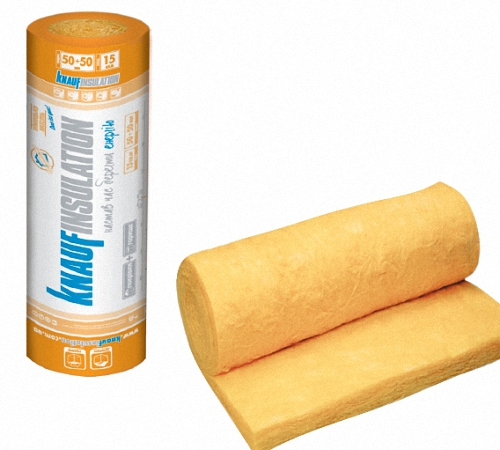
Consider the main types of insulation materials used in construction:
1. Foam insulation is a material based on expanded polystyrene, which has undergone special processing. This material is characterized by a low level of thermal conductivity and the ability to withstand huge loads of more than 40 tons per square meter. It has a wide range of applications, it is used for thermal insulation of pavement, walls, ceilings, foundations, attics, roofs, etc.
2. Insulation based on basalt fiber or basalt wool - is the most popular material used in low-rise construction. Differs in nonflammability, low thermal conductivity, vapor permeability. It is used in the process of insulating walls, floors, attics, interfloor sections and foundations.
3. Fiberglass-based insulation is used a little less often, they are used for almost any insulation. It has a good water-repellent effect, mold or fungus does not form on it over time.
4. The traditional and lowest-budget insulation is foam plastic - the main disadvantage of which is its easy ignition.
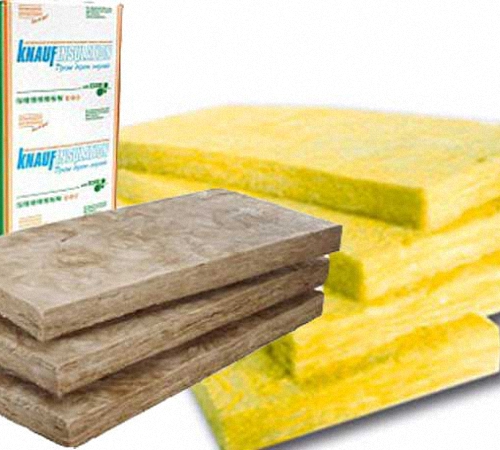
Features and benefits of using Knauf insulation
The manufacture of insulation "Knauf" is carried out by a German company, which has the same name with it. All Knauf products are famous for their high quality and have extremely positive reviews. This also applies to insulation, in its production only natural components are used that do not cause allergies and are absolutely harmless to health.
We offer you to get acquainted with the main advantages of Knauf heaters, which once again testify to their quality:
1. Insulating the house with products of the Knauf trademark, it turns out to save on heating.
2. Low coefficient of thermal conductivity allows you to retain heat and release it to the street.
3. The high level of noise absorption provides the heat-insulated surface not only with warmth, but also is an excellent sound insulator.
4. Fire safety and resistance to ignition is another advantage of Knauf insulation. This material is absolutely non-flammable.
5. A high level of biological stability protects the insulation from being eaten by rats or mice. Therefore, the material can be used for a long time.
6. Lack of an unpleasant smell, soft texture - provide comfort when working with this heater.
7. The possibility of compressing or buying a Knauf roll insulation is another of its advantages, which facilitates its transportation.
8. The practical absence of shrinkage and lightness do not load the walls and retain heat for a long time.
9. The manufacturer's warranty is more than forty years, so having installed such a heater for almost half a century, you do not need to worry about replacing it.
10. In the manufacture of Knauf heaters, neither dyes nor bleaches are used, so the quality remains at the proper level.
11. Convenient packaging reduces material resources for the transportation of insulation.
12. Knauf materials are easy to cut and do not prick, unlike analogues, so working with them is easy and comfortable.
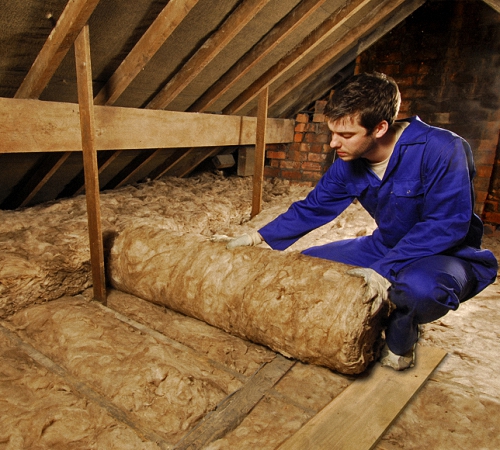
Scope of use of heaters "Knauf"
1. Knauf products are used in the process of wall insulation. It is both internal and external. It is better to produce external insulation, since when performing such actions, the freezing point moves to the outside of the wall, so more heat is stored in the building.
3. Thermal insulation of the roof can be both ventilated and non-ventilated. The first method prevents condensation and allows the roof to breathe.
4. Materials for thermal insulation of the Knauf company are used for installation on various types of roofs, both pitched and flat.
5. To prevent freezing of non-residential premises: warehouses or industrial buildings, Knauf insulation is also used.
6. For insulation of basements, balconies, loggias - plates with increased strength are used, which practically do not shrink.
7. To avoid heaving of the soil in the winter season, use the Knauf insulation, which is used to insulate the foundations and basement sections of the building.

Heaters "Knauf" characteristics and overview
Consider Knauf heaters made of glass wool. They are divided into:
- Knauf Insulation;
- Knauf or “Heat-Knauf.
The first version of insulation is characterized by high elastic properties; it is used for insulating the outer surfaces of walls: in residential, public and industrial premises.
There are several types of Knauf insulation that are used for insulation:
- facades;
- roofing;
- partitions.
Insulation for the facade is installed on the outer walls, produced in the form of plates. One package contains eight to sixteen pieces.
The second option is used in the process of roof insulation. Available in two forms: tile or matte. The package packs the required amount of material from one piece to twenty-four.
In the process of constructing residential, public or industrial buildings, such as high-rise buildings, shops, theaters and restaurants, a third version of external insulation is used. The package contains four to twenty-four plates or four rolls, according to the required shape.
The use of "TeploKnauf" is associated with the insulation of residential premises, such as a house or a summer house. This insulation can be of several types:
- "Knauf Cottage" - has excellent soundproofing properties, provides a high level of thermal insulation, is a universal material with which both the roof and walls are insulated, the presence of hydroimpregnation increases the water-repellent effect, the thickness of the plates is 50 mm;
- “Knauf Cottage Plus” - has the same characteristics as the previous material, but the layer thickness is 100 mm, therefore it is more reliable and of high quality;
- “Knauf Dacha” is a cheaper type of insulation that is installed in rooms in which people live periodically, for example, in a country house, since in severe frost this material is not able to fully perform its functions;
- "Knauf Dom" - increases the thermal insulation properties of both walls and roofs in private houses, apartments and other residential premises, the plates have a thickness of 50 mm;
- “Knauf Dom Plus” - has the same features and functions as “Knauf Dom”, only it has a higher level of thermal insulation and a thickness of 100 mm.
In addition to glass wool insulation, the Knauf company is engaged in the production of polystyrene insulation. They are produced in the Knauf Therm series.
Expanded polystyrene is a material that has the following characteristics:
- high sound insulation;
- high water-repellent effect, this aspect is especially important in the process of roof insulation;
- this material is not subject to decay, the development of mold, fungus and other microorganisms;
- is absolutely harmless and environmentally friendly material;
- includes special additives that improve the quality of fire safety and incombustibility;
- good geometric shapes of the plates, virtually eliminate the risk of cracks during their installation;
- do not require special clothing and respirators when working with polystyrene foam;
- much easier to plaster than mineral wool;
- have a long service life, which exceeds thirty years.

The Knauf Therm series contains materials that allow you to insulate rooms, floors, walls and facades of wooden houses.
Plates are produced in a standard size: 120 cm by 10 cm. Custom plates can be ordered. Consider the main types of Knauf Therm thermal insulation materials and their features:
1. Knauf Therm FLOOR - heat-insulating moisture-resistant insulation, which is produced in the form of plates, has increased strength, is suitable for performing heat-insulating work on all types of floors, plinth, blind areas and foundation walls, the depth of which does not exceed three meters.
Peculiarities:
- does not contain or emit harmful substances;
- able to withstand a load of more than 14 tons per 1 m²;
- does not shrink;
- low thermal conductivity.
2. Knauf Therm "Facade" - used for external insulation of walls of any buildings. They are used for the construction of a facade system with plaster, which is laid in a thin layer. The installation of these plates is carried out in the following steps:
- if necessary, the plates are sawn to the desired size;
- installed and fixed with mounting adhesive and dowel system;
- a protective layer is created with a plaster-adhesive mass, which, after drying, is covered with a decorative layer.
When installing these plates, the presence of small gaps between them is not allowed.
Advantages:
- environmental Safety;
- high level of strength;
- fire safety;
- no shrinkage.
3. Knauf Therm Roof - a heat-insulating material that is used in the process of flat roof insulation. They can be used for flat roofs with a base of concrete or reinforced concrete material or in the insulation of flat roofs from metal profiled sheets.
Peculiarities:
- environmental friendliness;
- non-flammability;
- ease of installation;
- a light weight;
- resistance to moisture.
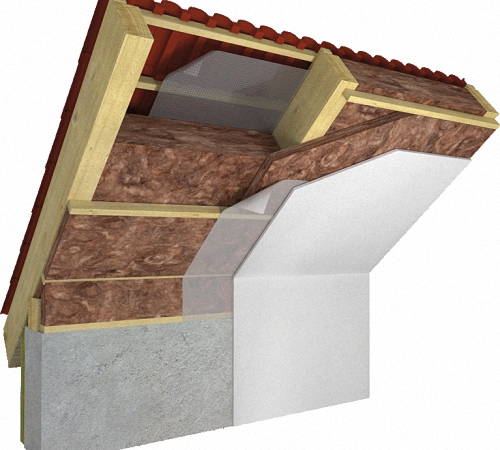
4. Knauf Therm “Walls” - used in the conduct of thermal insulation work on various types of walls.
Scope of use:
- walls with cladding or lining;
- frame walls;
- hinged facade systems with air gaps;
- partitions of frames made of metal or wood;
- during the production of concrete or reinforced concrete panels.
5. Knauf Therm Roof NL - plates are designed for thermal insulation, they are used when working on the roof, they are distinguished by increased strength characteristics.
Allows thermal insulation on a flat or pitched roof. Plates differ in ease and convenience of installation, moisture resistant, fireproof. They don't shrink.
6. "Knauf Therm D" five in one - plates that allow for insulation under increased load.
Scope of use:
- with thermal insulation of the foundation, the depth of which does not exceed six meters;
- for thermal insulation of roofs and floors with additional load;
- are used to protect the waterproofing of load-bearing walls, due to their susceptibility to mechanical damage;
- improve the outflow of water in the outer walls of the basement.
Advantages:
- absence of phenol formaldehyde;
- the ability to withstand loads of about twenty tons or more;
- moisture resistance;
- the stepped edge of the plates does not need to be sealed;
- to simplify the cutting process, special markings are applied to the plates;
- a special textured surface improves the quality of the adhesive and increases the adhesion of the plate to the wall.
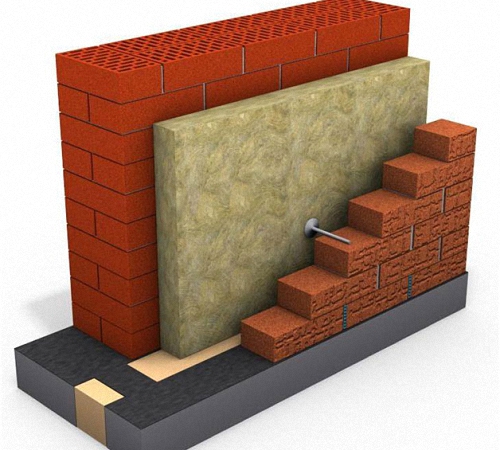
7. "Knauf Therm S" 5 in 1 - plates are used for insulation of the facade or outer wall of the building.
Plate installation includes:
- installation and fixation of thermal insulation with mounting foam, glue or dowels;
- construction of a protective layer, which consists of plaster and glue;
- applying a decorative texture layer.
Advantages:
- safety of use;
- water-repellent properties;
- does not need sealing seams;
- easy to cut and install;
- has a high level of adhesion to the surface.
8. “Knauf Therm F” 5 in 1 - plates that allow you to insulate walls, building foundations or floors.
Scope of application:
- different types of floors;
- flat roof;
- facade parts of the building;
- garden paths;
- balconies;
- foundation and basement parts;
- basements.
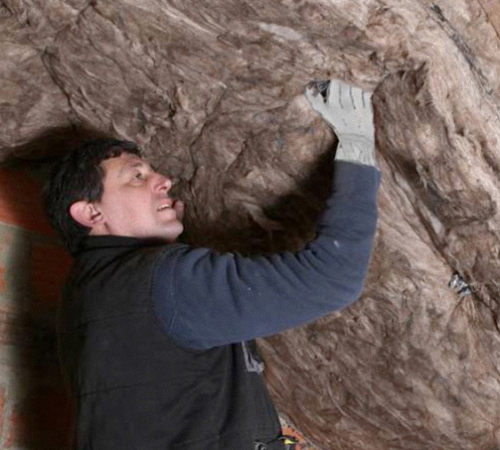
A distinctive feature of this heat-insulating material is the ability to withstand loads that exceed 15 tons per square meter. The material is easily and conveniently transported.
9. Knauf Therm Concrete - insulation boards, which are characterized by increased strength, allow you to insulate floors of various purposes.
Are used in the device of "floating floors" or self-leveling screeds. The material does not rot or mold, is not attractive to mice and other rodents, and therefore can last for quite a long time. Plates withstand loads up to ten tons per square meter.
10. Knauf Therm Compack - an insulating material that is used in suburban construction or renovation of premises.
Scope of use:
- thermal insulation of a pitched roof;
- attic;
- walls both outside and inside the room;
- insulation of attic spaces and mezhetaenyh areas;
- earth floors and basements.
Peculiarities:
- the ability to withstand loads up to six tons;
- providing additional protection against leakage;
- high thermal insulation properties;
- environmental Safety.
1. To buy Knauf insulation, contact a specialized hardware store, where experienced consultants will help you calculate the required amount of material.
2. The price for Knauf insulation depends on such factors:
- type of insulation;
- the amount of material needed;
- place of insulation.
3. Studying the reviews about the Knauf insulation, we conclude that its only drawback is the high cost, compared with heaters from other manufacturers. But, the purchase of Knauf insulation gives its owner high quality thermal insulation, which pays off within two to three years and a long service life of fifty years.

4. When choosing a Knauf heater, pay attention to its technical characteristics, each series of heaters is intended for different places of insulation.
5. Be sure to purchase mounting foam or dowels to fix the insulation.
6. When insulating the surface, it is also necessary to take care of vapor barrier, wind insulation and waterproofing.
7. Pay attention to the thickness of the insulation, for walls its value is less than for the floor.
8. To insulate a pitched roof, use fiberglass or basalt-based insulation.
9. The use of expanded polystyrene, which has a water-repellent effect, is associated with the insulation of the foundation.
 budivel.ru About the insulation and heating of the house.
budivel.ru About the insulation and heating of the house.

